University Project: HRMS Implementation Project Management Assignment
VerifiedAdded on 2022/09/14
|15
|2002
|54
Project
AI Summary
This project management assignment details the implementation of a Human Resource Management System (HRMS) within the retail industry. The assignment begins with a scope statement, outlining the project's background, objectives (maximizing employee performance and operational efficiency), goals, assumptions, in-scope and out-of-scope work, deliverables (HRMS project initiation plan, budget plan, communication management plan, etc.), and milestones. The project aims to centralize HR functions, improve employee visibility, and streamline processes. A Work Breakdown Structure (WBS) is then presented, breaking down the project into manageable tasks and sub-activities, including project initiation, evaluation, implementation, go-live, post-live evaluation, system implementation, post-live training, and final closure phases. The WBS is accompanied by a dictionary explaining each component. Technical requirements such as networked client/server, Windows NT OS, and computing languages like SQL, Java, and C++ are also defined. The assignment highlights dependencies between project phases and the exclusion of business process changes and data alterations. The project's goal is to maximize employee performance and operational efficiency, reduce IT costs, improve employee satisfaction, and increase business revenue.
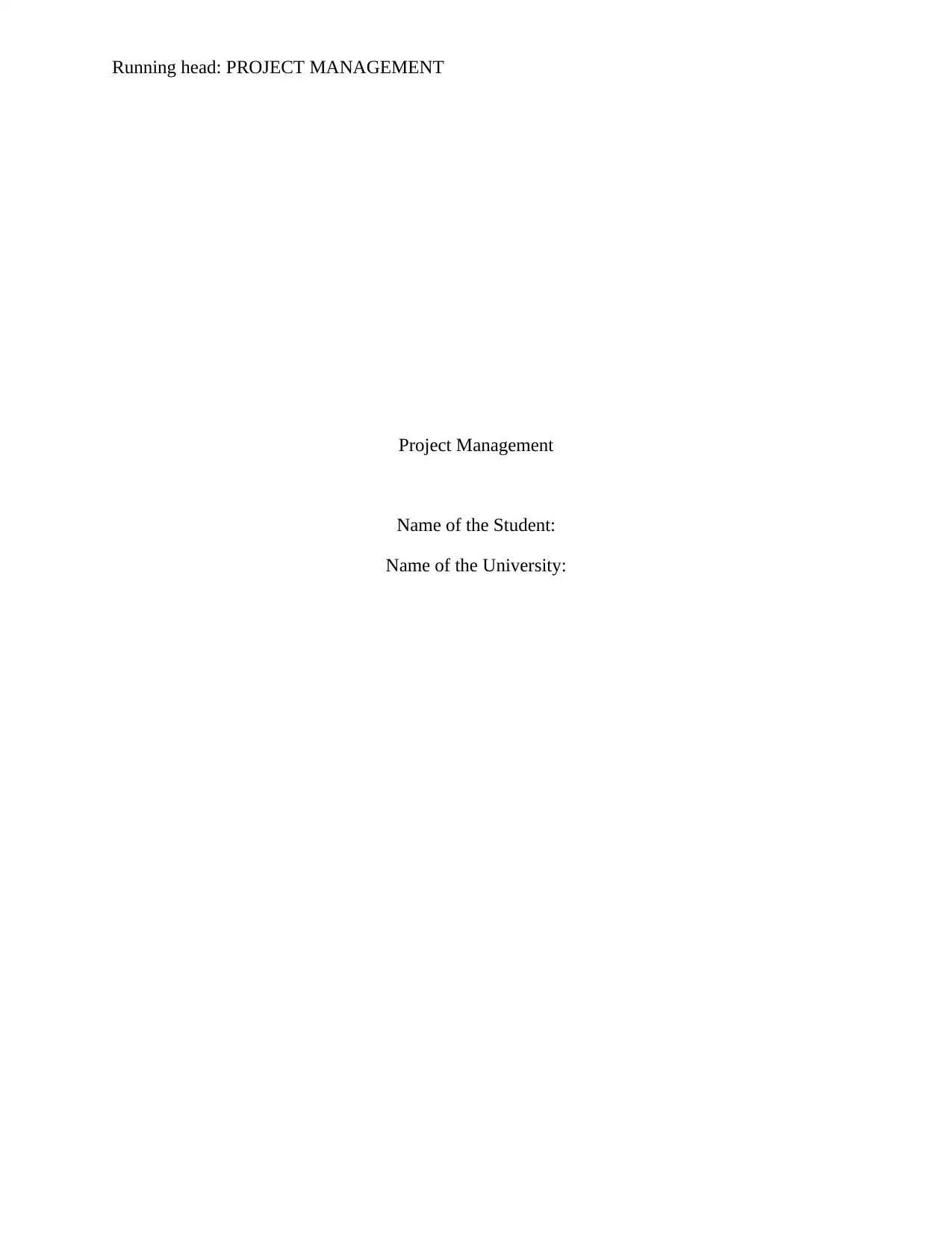
Running head: PROJECT MANAGEMENT
Project Management
Name of the Student:
Name of the University:
Project Management
Name of the Student:
Name of the University:
Paraphrase This Document
Need a fresh take? Get an instant paraphrase of this document with our AI Paraphraser
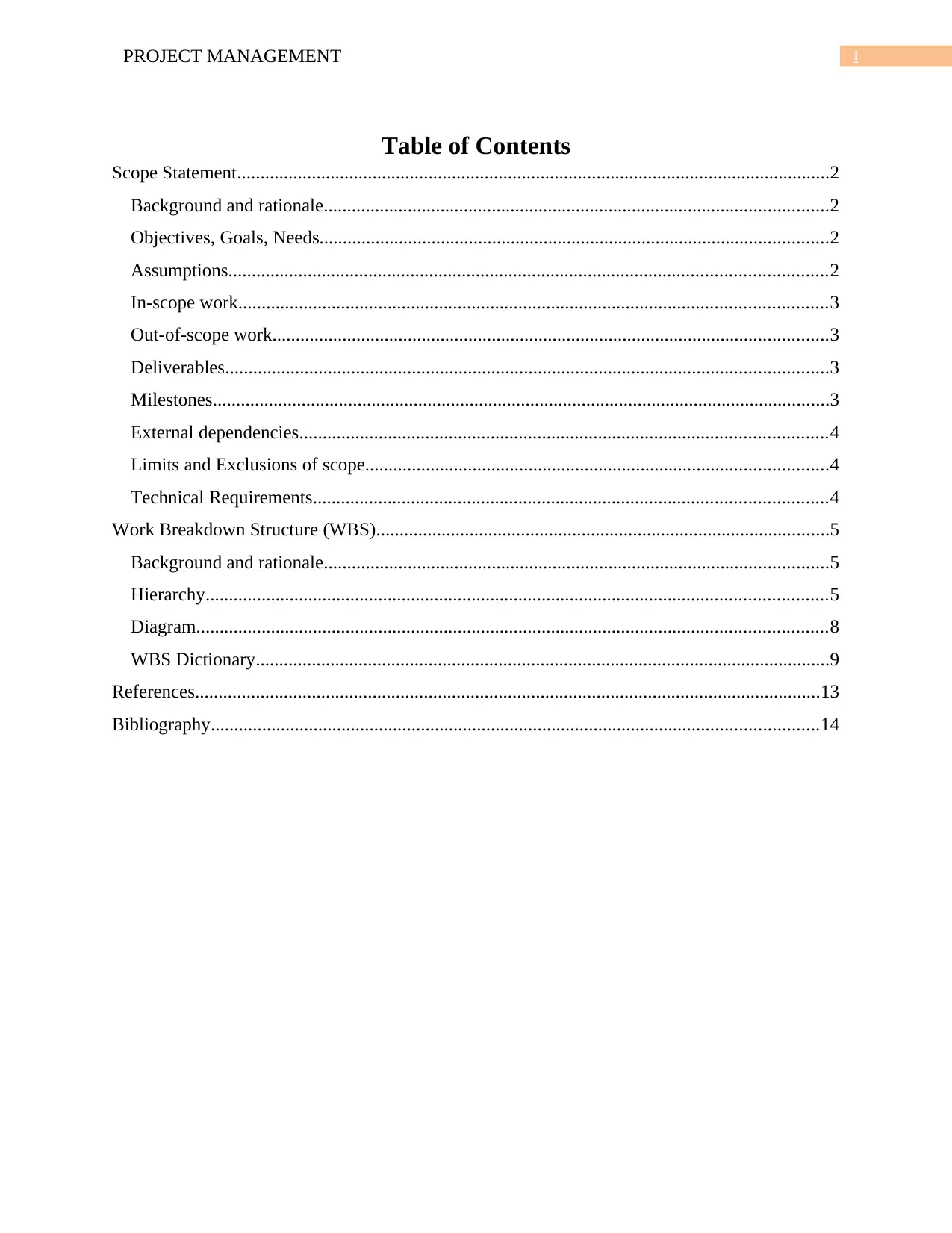
1PROJECT MANAGEMENT
Table of Contents
Scope Statement...............................................................................................................................2
Background and rationale............................................................................................................2
Objectives, Goals, Needs.............................................................................................................2
Assumptions................................................................................................................................2
In-scope work..............................................................................................................................3
Out-of-scope work.......................................................................................................................3
Deliverables.................................................................................................................................3
Milestones....................................................................................................................................3
External dependencies.................................................................................................................4
Limits and Exclusions of scope...................................................................................................4
Technical Requirements..............................................................................................................4
Work Breakdown Structure (WBS).................................................................................................5
Background and rationale............................................................................................................5
Hierarchy.....................................................................................................................................5
Diagram.......................................................................................................................................8
WBS Dictionary...........................................................................................................................9
References......................................................................................................................................13
Bibliography..................................................................................................................................14
Table of Contents
Scope Statement...............................................................................................................................2
Background and rationale............................................................................................................2
Objectives, Goals, Needs.............................................................................................................2
Assumptions................................................................................................................................2
In-scope work..............................................................................................................................3
Out-of-scope work.......................................................................................................................3
Deliverables.................................................................................................................................3
Milestones....................................................................................................................................3
External dependencies.................................................................................................................4
Limits and Exclusions of scope...................................................................................................4
Technical Requirements..............................................................................................................4
Work Breakdown Structure (WBS).................................................................................................5
Background and rationale............................................................................................................5
Hierarchy.....................................................................................................................................5
Diagram.......................................................................................................................................8
WBS Dictionary...........................................................................................................................9
References......................................................................................................................................13
Bibliography..................................................................................................................................14
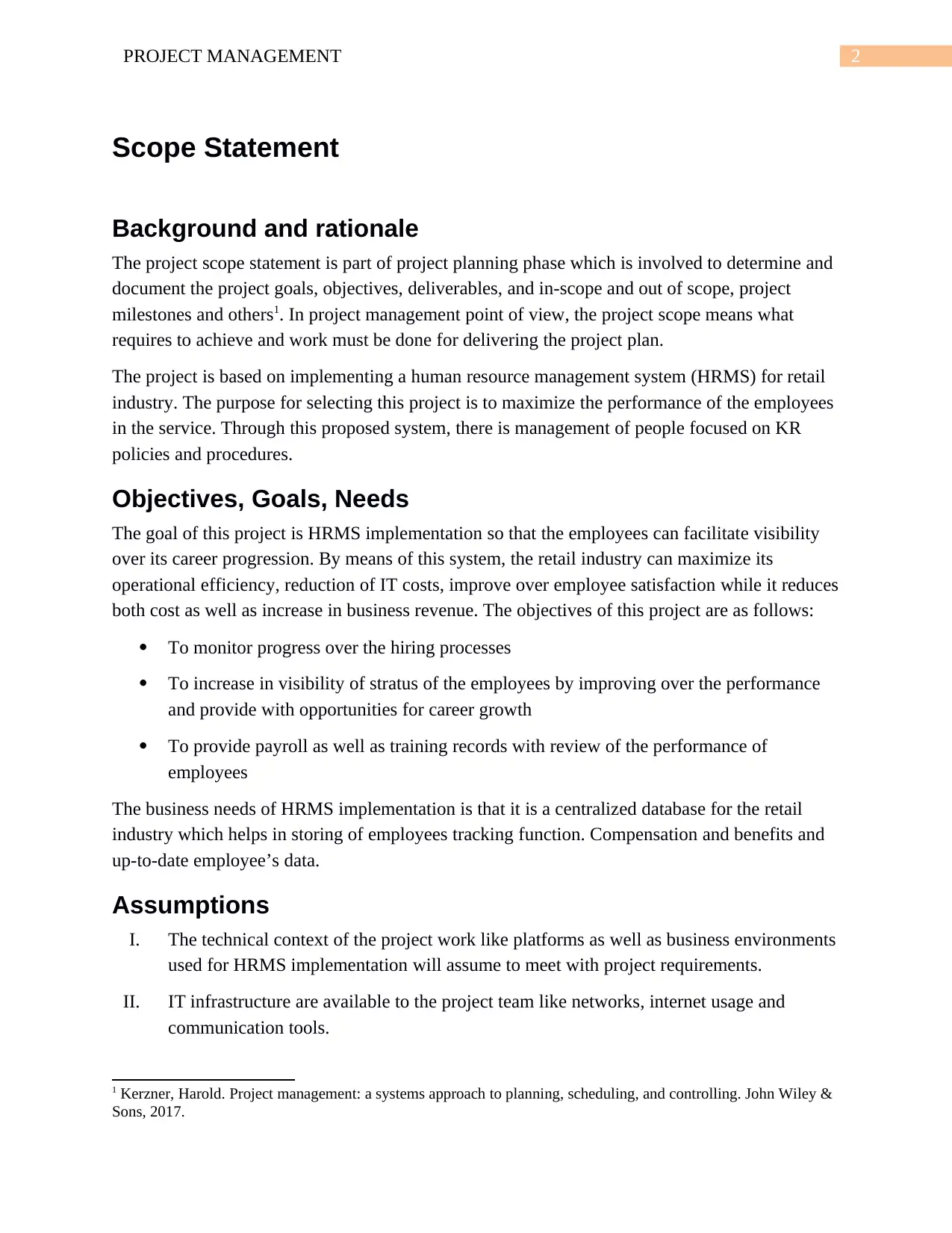
2PROJECT MANAGEMENT
Scope Statement
Background and rationale
The project scope statement is part of project planning phase which is involved to determine and
document the project goals, objectives, deliverables, and in-scope and out of scope, project
milestones and others1. In project management point of view, the project scope means what
requires to achieve and work must be done for delivering the project plan.
The project is based on implementing a human resource management system (HRMS) for retail
industry. The purpose for selecting this project is to maximize the performance of the employees
in the service. Through this proposed system, there is management of people focused on KR
policies and procedures.
Objectives, Goals, Needs
The goal of this project is HRMS implementation so that the employees can facilitate visibility
over its career progression. By means of this system, the retail industry can maximize its
operational efficiency, reduction of IT costs, improve over employee satisfaction while it reduces
both cost as well as increase in business revenue. The objectives of this project are as follows:
To monitor progress over the hiring processes
To increase in visibility of stratus of the employees by improving over the performance
and provide with opportunities for career growth
To provide payroll as well as training records with review of the performance of
employees
The business needs of HRMS implementation is that it is a centralized database for the retail
industry which helps in storing of employees tracking function. Compensation and benefits and
up-to-date employee’s data.
Assumptions
I. The technical context of the project work like platforms as well as business environments
used for HRMS implementation will assume to meet with project requirements.
II. IT infrastructure are available to the project team like networks, internet usage and
communication tools.
1 Kerzner, Harold. Project management: a systems approach to planning, scheduling, and controlling. John Wiley &
Sons, 2017.
Scope Statement
Background and rationale
The project scope statement is part of project planning phase which is involved to determine and
document the project goals, objectives, deliverables, and in-scope and out of scope, project
milestones and others1. In project management point of view, the project scope means what
requires to achieve and work must be done for delivering the project plan.
The project is based on implementing a human resource management system (HRMS) for retail
industry. The purpose for selecting this project is to maximize the performance of the employees
in the service. Through this proposed system, there is management of people focused on KR
policies and procedures.
Objectives, Goals, Needs
The goal of this project is HRMS implementation so that the employees can facilitate visibility
over its career progression. By means of this system, the retail industry can maximize its
operational efficiency, reduction of IT costs, improve over employee satisfaction while it reduces
both cost as well as increase in business revenue. The objectives of this project are as follows:
To monitor progress over the hiring processes
To increase in visibility of stratus of the employees by improving over the performance
and provide with opportunities for career growth
To provide payroll as well as training records with review of the performance of
employees
The business needs of HRMS implementation is that it is a centralized database for the retail
industry which helps in storing of employees tracking function. Compensation and benefits and
up-to-date employee’s data.
Assumptions
I. The technical context of the project work like platforms as well as business environments
used for HRMS implementation will assume to meet with project requirements.
II. IT infrastructure are available to the project team like networks, internet usage and
communication tools.
1 Kerzner, Harold. Project management: a systems approach to planning, scheduling, and controlling. John Wiley &
Sons, 2017.
⊘ This is a preview!⊘
Do you want full access?
Subscribe today to unlock all pages.

Trusted by 1+ million students worldwide
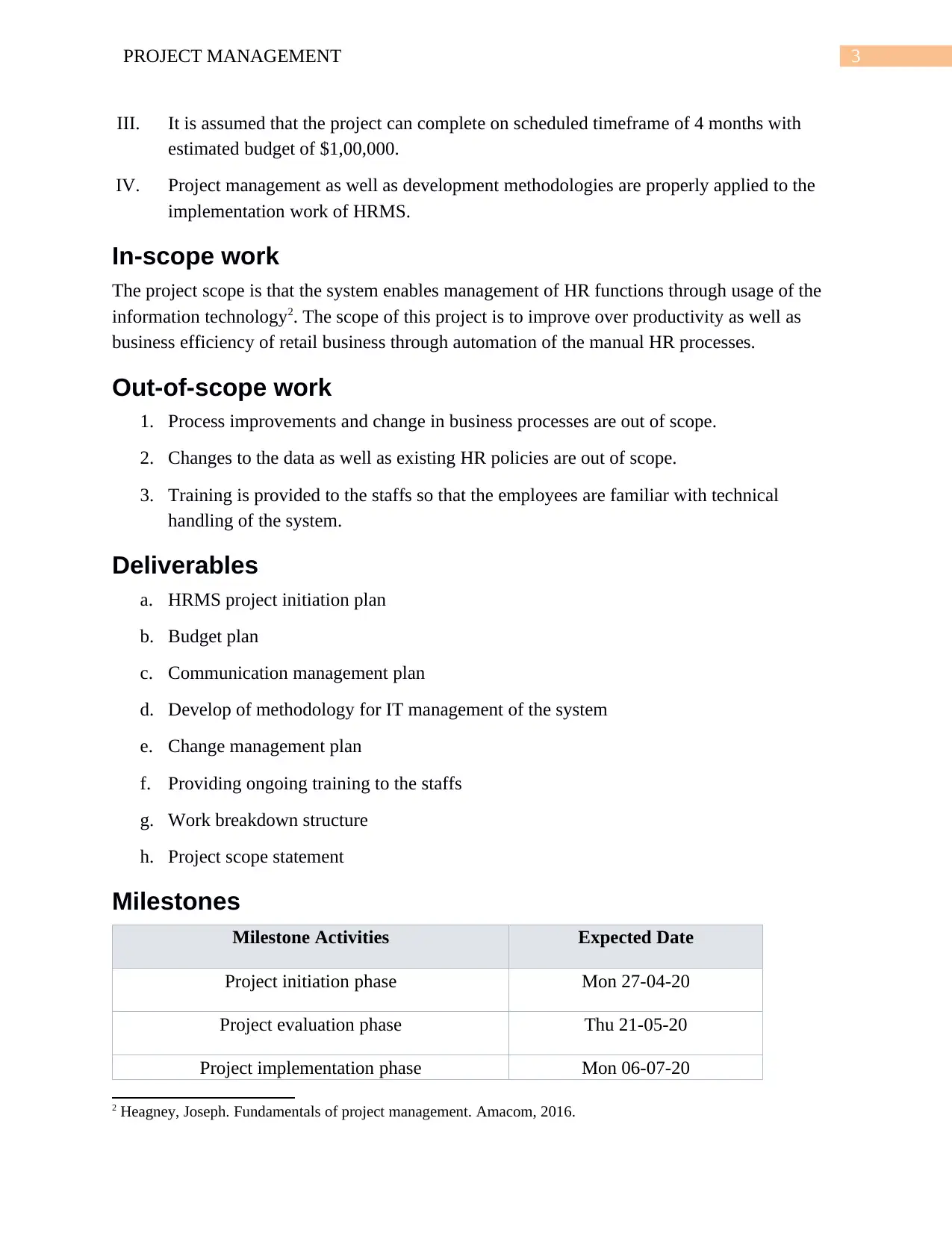
3PROJECT MANAGEMENT
III. It is assumed that the project can complete on scheduled timeframe of 4 months with
estimated budget of $1,00,000.
IV. Project management as well as development methodologies are properly applied to the
implementation work of HRMS.
In-scope work
The project scope is that the system enables management of HR functions through usage of the
information technology2. The scope of this project is to improve over productivity as well as
business efficiency of retail business through automation of the manual HR processes.
Out-of-scope work
1. Process improvements and change in business processes are out of scope.
2. Changes to the data as well as existing HR policies are out of scope.
3. Training is provided to the staffs so that the employees are familiar with technical
handling of the system.
Deliverables
a. HRMS project initiation plan
b. Budget plan
c. Communication management plan
d. Develop of methodology for IT management of the system
e. Change management plan
f. Providing ongoing training to the staffs
g. Work breakdown structure
h. Project scope statement
Milestones
Milestone Activities Expected Date
Project initiation phase Mon 27-04-20
Project evaluation phase Thu 21-05-20
Project implementation phase Mon 06-07-20
2 Heagney, Joseph. Fundamentals of project management. Amacom, 2016.
III. It is assumed that the project can complete on scheduled timeframe of 4 months with
estimated budget of $1,00,000.
IV. Project management as well as development methodologies are properly applied to the
implementation work of HRMS.
In-scope work
The project scope is that the system enables management of HR functions through usage of the
information technology2. The scope of this project is to improve over productivity as well as
business efficiency of retail business through automation of the manual HR processes.
Out-of-scope work
1. Process improvements and change in business processes are out of scope.
2. Changes to the data as well as existing HR policies are out of scope.
3. Training is provided to the staffs so that the employees are familiar with technical
handling of the system.
Deliverables
a. HRMS project initiation plan
b. Budget plan
c. Communication management plan
d. Develop of methodology for IT management of the system
e. Change management plan
f. Providing ongoing training to the staffs
g. Work breakdown structure
h. Project scope statement
Milestones
Milestone Activities Expected Date
Project initiation phase Mon 27-04-20
Project evaluation phase Thu 21-05-20
Project implementation phase Mon 06-07-20
2 Heagney, Joseph. Fundamentals of project management. Amacom, 2016.
Paraphrase This Document
Need a fresh take? Get an instant paraphrase of this document with our AI Paraphraser
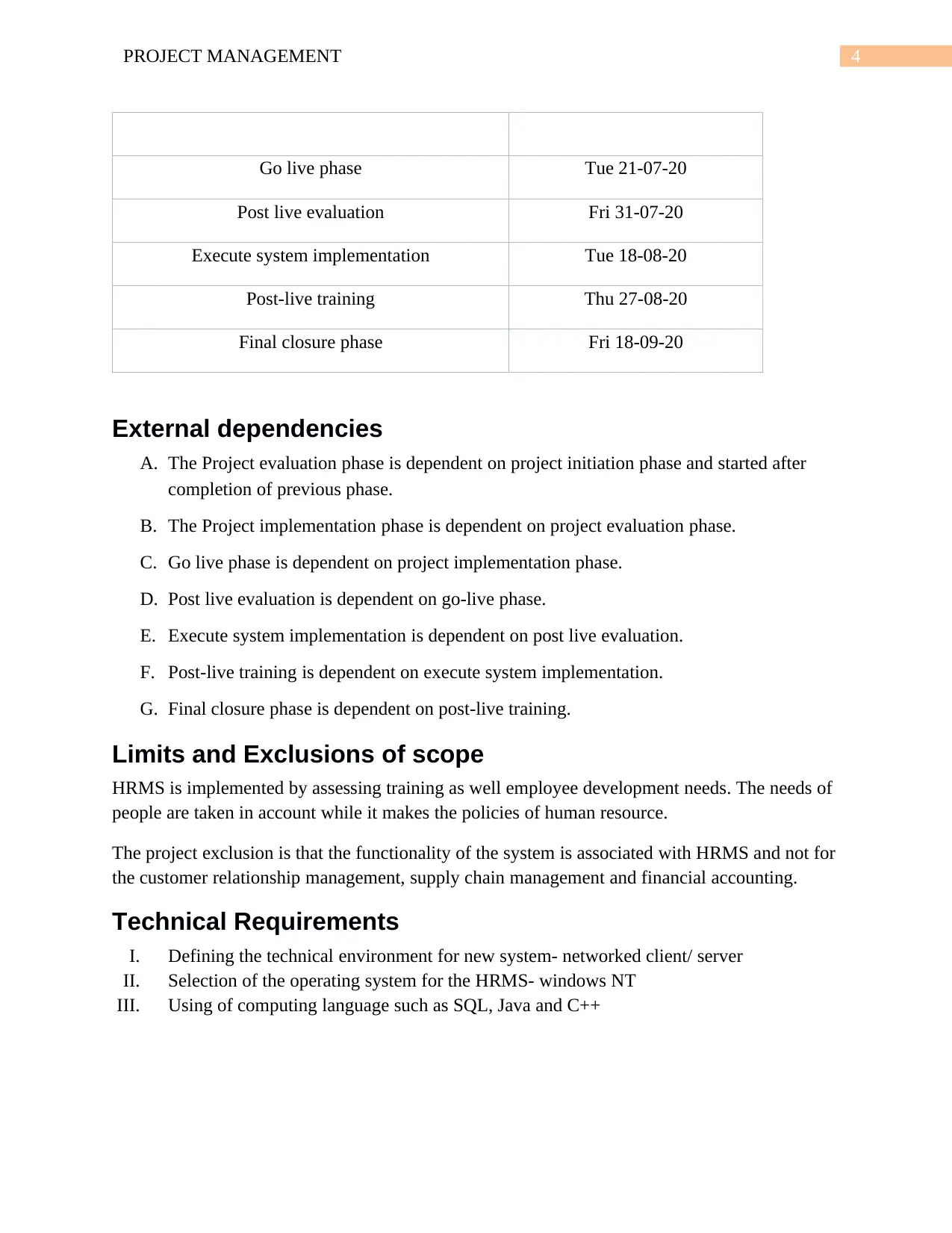
4PROJECT MANAGEMENT
Go live phase Tue 21-07-20
Post live evaluation Fri 31-07-20
Execute system implementation Tue 18-08-20
Post-live training Thu 27-08-20
Final closure phase Fri 18-09-20
External dependencies
A. The Project evaluation phase is dependent on project initiation phase and started after
completion of previous phase.
B. The Project implementation phase is dependent on project evaluation phase.
C. Go live phase is dependent on project implementation phase.
D. Post live evaluation is dependent on go-live phase.
E. Execute system implementation is dependent on post live evaluation.
F. Post-live training is dependent on execute system implementation.
G. Final closure phase is dependent on post-live training.
Limits and Exclusions of scope
HRMS is implemented by assessing training as well employee development needs. The needs of
people are taken in account while it makes the policies of human resource.
The project exclusion is that the functionality of the system is associated with HRMS and not for
the customer relationship management, supply chain management and financial accounting.
Technical Requirements
I. Defining the technical environment for new system- networked client/ server
II. Selection of the operating system for the HRMS- windows NT
III. Using of computing language such as SQL, Java and C++
Go live phase Tue 21-07-20
Post live evaluation Fri 31-07-20
Execute system implementation Tue 18-08-20
Post-live training Thu 27-08-20
Final closure phase Fri 18-09-20
External dependencies
A. The Project evaluation phase is dependent on project initiation phase and started after
completion of previous phase.
B. The Project implementation phase is dependent on project evaluation phase.
C. Go live phase is dependent on project implementation phase.
D. Post live evaluation is dependent on go-live phase.
E. Execute system implementation is dependent on post live evaluation.
F. Post-live training is dependent on execute system implementation.
G. Final closure phase is dependent on post-live training.
Limits and Exclusions of scope
HRMS is implemented by assessing training as well employee development needs. The needs of
people are taken in account while it makes the policies of human resource.
The project exclusion is that the functionality of the system is associated with HRMS and not for
the customer relationship management, supply chain management and financial accounting.
Technical Requirements
I. Defining the technical environment for new system- networked client/ server
II. Selection of the operating system for the HRMS- windows NT
III. Using of computing language such as SQL, Java and C++
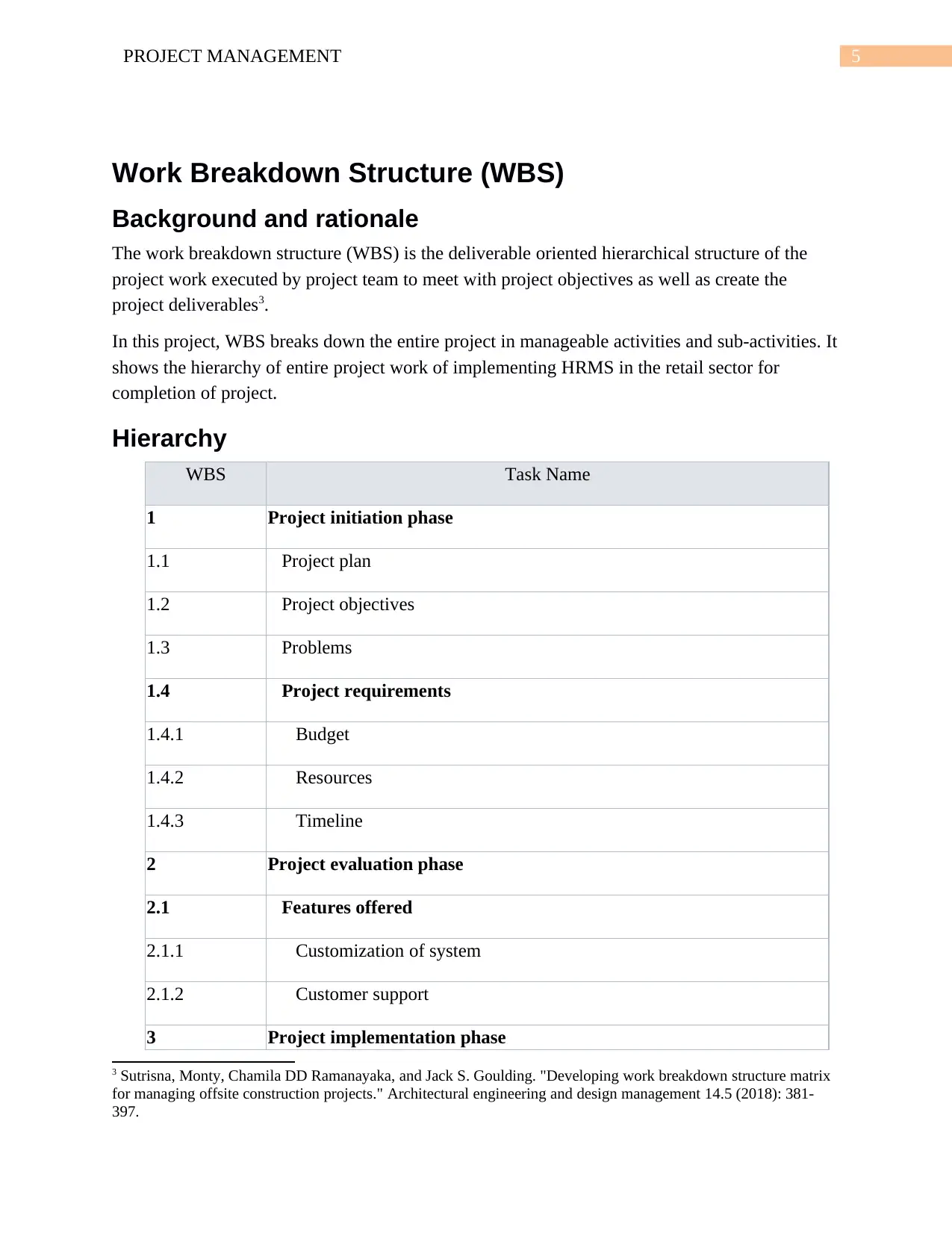
5PROJECT MANAGEMENT
Work Breakdown Structure (WBS)
Background and rationale
The work breakdown structure (WBS) is the deliverable oriented hierarchical structure of the
project work executed by project team to meet with project objectives as well as create the
project deliverables3.
In this project, WBS breaks down the entire project in manageable activities and sub-activities. It
shows the hierarchy of entire project work of implementing HRMS in the retail sector for
completion of project.
Hierarchy
WBS Task Name
1 Project initiation phase
1.1 Project plan
1.2 Project objectives
1.3 Problems
1.4 Project requirements
1.4.1 Budget
1.4.2 Resources
1.4.3 Timeline
2 Project evaluation phase
2.1 Features offered
2.1.1 Customization of system
2.1.2 Customer support
3 Project implementation phase
3 Sutrisna, Monty, Chamila DD Ramanayaka, and Jack S. Goulding. "Developing work breakdown structure matrix
for managing offsite construction projects." Architectural engineering and design management 14.5 (2018): 381-
397.
Work Breakdown Structure (WBS)
Background and rationale
The work breakdown structure (WBS) is the deliverable oriented hierarchical structure of the
project work executed by project team to meet with project objectives as well as create the
project deliverables3.
In this project, WBS breaks down the entire project in manageable activities and sub-activities. It
shows the hierarchy of entire project work of implementing HRMS in the retail sector for
completion of project.
Hierarchy
WBS Task Name
1 Project initiation phase
1.1 Project plan
1.2 Project objectives
1.3 Problems
1.4 Project requirements
1.4.1 Budget
1.4.2 Resources
1.4.3 Timeline
2 Project evaluation phase
2.1 Features offered
2.1.1 Customization of system
2.1.2 Customer support
3 Project implementation phase
3 Sutrisna, Monty, Chamila DD Ramanayaka, and Jack S. Goulding. "Developing work breakdown structure matrix
for managing offsite construction projects." Architectural engineering and design management 14.5 (2018): 381-
397.
⊘ This is a preview!⊘
Do you want full access?
Subscribe today to unlock all pages.

Trusted by 1+ million students worldwide
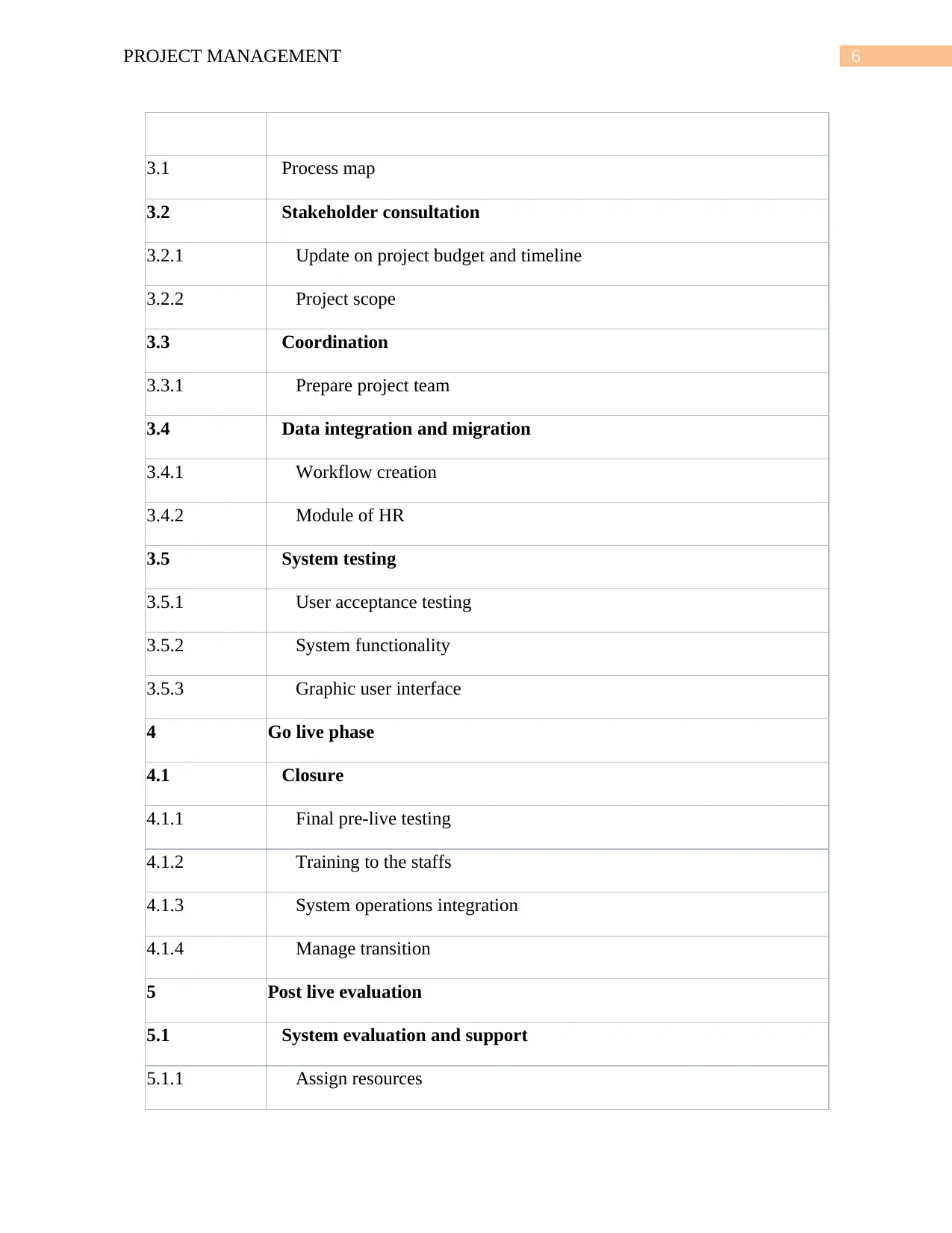
6PROJECT MANAGEMENT
3.1 Process map
3.2 Stakeholder consultation
3.2.1 Update on project budget and timeline
3.2.2 Project scope
3.3 Coordination
3.3.1 Prepare project team
3.4 Data integration and migration
3.4.1 Workflow creation
3.4.2 Module of HR
3.5 System testing
3.5.1 User acceptance testing
3.5.2 System functionality
3.5.3 Graphic user interface
4 Go live phase
4.1 Closure
4.1.1 Final pre-live testing
4.1.2 Training to the staffs
4.1.3 System operations integration
4.1.4 Manage transition
5 Post live evaluation
5.1 System evaluation and support
5.1.1 Assign resources
3.1 Process map
3.2 Stakeholder consultation
3.2.1 Update on project budget and timeline
3.2.2 Project scope
3.3 Coordination
3.3.1 Prepare project team
3.4 Data integration and migration
3.4.1 Workflow creation
3.4.2 Module of HR
3.5 System testing
3.5.1 User acceptance testing
3.5.2 System functionality
3.5.3 Graphic user interface
4 Go live phase
4.1 Closure
4.1.1 Final pre-live testing
4.1.2 Training to the staffs
4.1.3 System operations integration
4.1.4 Manage transition
5 Post live evaluation
5.1 System evaluation and support
5.1.1 Assign resources
Paraphrase This Document
Need a fresh take? Get an instant paraphrase of this document with our AI Paraphraser
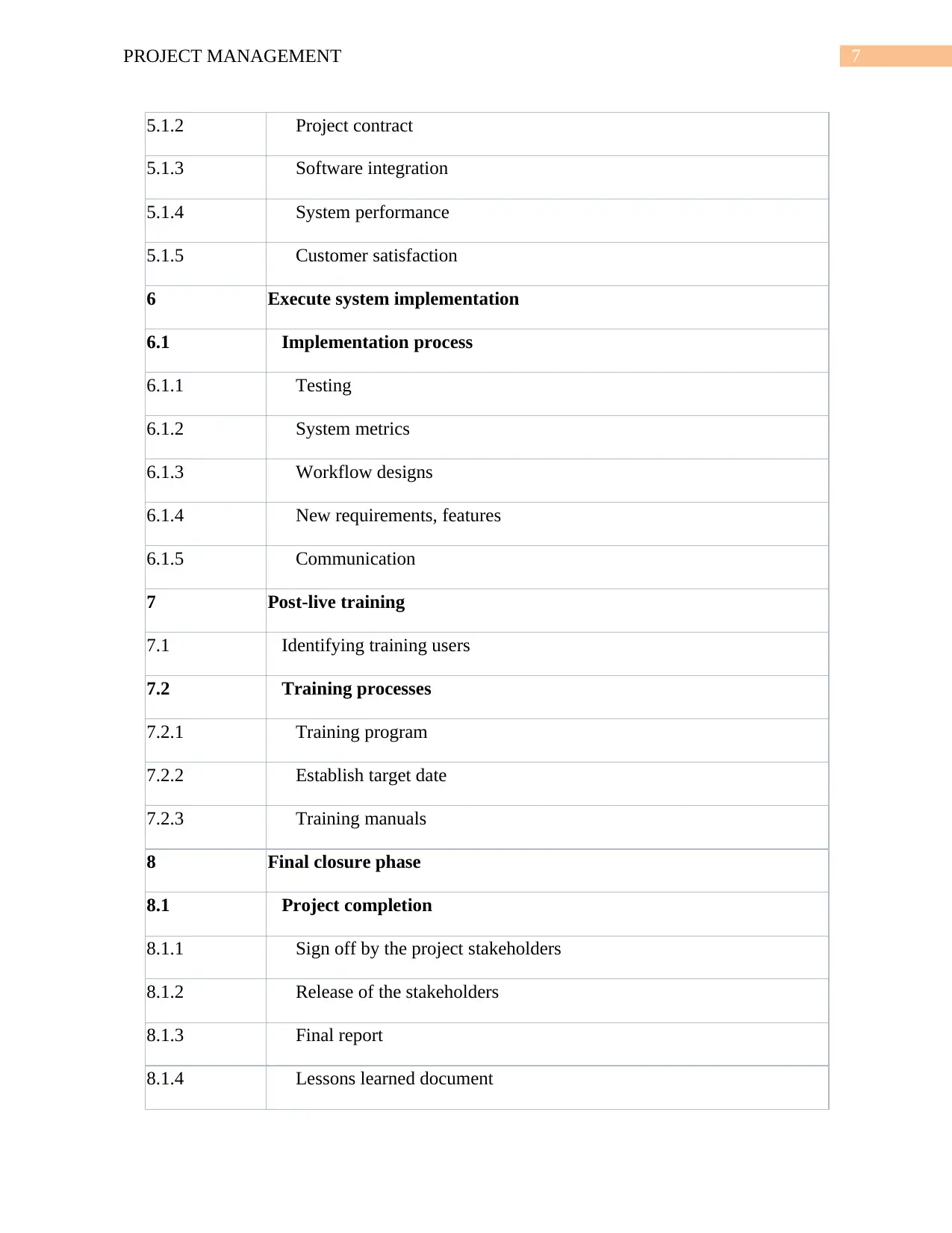
7PROJECT MANAGEMENT
5.1.2 Project contract
5.1.3 Software integration
5.1.4 System performance
5.1.5 Customer satisfaction
6 Execute system implementation
6.1 Implementation process
6.1.1 Testing
6.1.2 System metrics
6.1.3 Workflow designs
6.1.4 New requirements, features
6.1.5 Communication
7 Post-live training
7.1 Identifying training users
7.2 Training processes
7.2.1 Training program
7.2.2 Establish target date
7.2.3 Training manuals
8 Final closure phase
8.1 Project completion
8.1.1 Sign off by the project stakeholders
8.1.2 Release of the stakeholders
8.1.3 Final report
8.1.4 Lessons learned document
5.1.2 Project contract
5.1.3 Software integration
5.1.4 System performance
5.1.5 Customer satisfaction
6 Execute system implementation
6.1 Implementation process
6.1.1 Testing
6.1.2 System metrics
6.1.3 Workflow designs
6.1.4 New requirements, features
6.1.5 Communication
7 Post-live training
7.1 Identifying training users
7.2 Training processes
7.2.1 Training program
7.2.2 Establish target date
7.2.3 Training manuals
8 Final closure phase
8.1 Project completion
8.1.1 Sign off by the project stakeholders
8.1.2 Release of the stakeholders
8.1.3 Final report
8.1.4 Lessons learned document
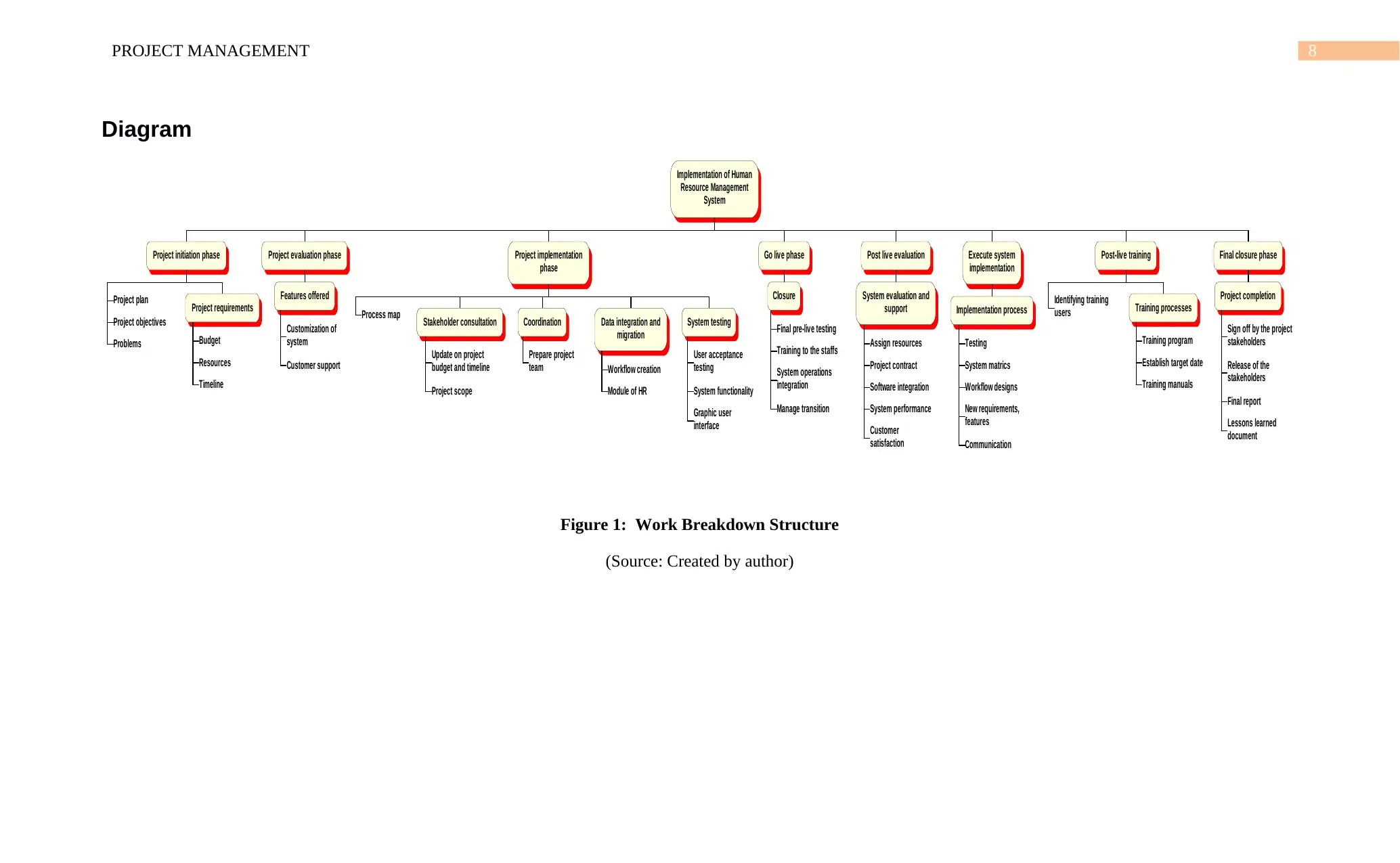
8PROJECT MANAGEMENT
Diagram
Implementation of Human
Resource Management
System
Project initiation phase
Project plan
Project objectives
Problems
Project requirements
Budget
Resources
Timeline
Project evaluation phase
Features offered
Customization of
system
Customer support
Project implementation
phase
Process map Stakeholder consultation
Update on project
budget and timeline
Project scope
Coordination
Prepare project
team
Data integration and
migration
Workflow creation
Module of HR
System testing
User acceptance
testing
System functionality
Graphic user
interface
Go live phase
Closure
Final pre-live testing
Training to the staffs
System operations
integration
Manage transition
Post live evaluation
System evaluation and
support
Assign resources
Project contract
Software integration
System performance
Customer
satisfaction
Execute system
implementation
Implementation process
Testing
System matrics
Workflow designs
New requirements,
features
Communication
Post-live training
Identifying training
users Training processes
Training program
Establish target date
Training manuals
Final closure phase
Project completion
Sign off by the project
stakeholders
Release of the
stakeholders
Final report
Lessons learned
document
Figure 1: Work Breakdown Structure
(Source: Created by author)
Diagram
Implementation of Human
Resource Management
System
Project initiation phase
Project plan
Project objectives
Problems
Project requirements
Budget
Resources
Timeline
Project evaluation phase
Features offered
Customization of
system
Customer support
Project implementation
phase
Process map Stakeholder consultation
Update on project
budget and timeline
Project scope
Coordination
Prepare project
team
Data integration and
migration
Workflow creation
Module of HR
System testing
User acceptance
testing
System functionality
Graphic user
interface
Go live phase
Closure
Final pre-live testing
Training to the staffs
System operations
integration
Manage transition
Post live evaluation
System evaluation and
support
Assign resources
Project contract
Software integration
System performance
Customer
satisfaction
Execute system
implementation
Implementation process
Testing
System matrics
Workflow designs
New requirements,
features
Communication
Post-live training
Identifying training
users Training processes
Training program
Establish target date
Training manuals
Final closure phase
Project completion
Sign off by the project
stakeholders
Release of the
stakeholders
Final report
Lessons learned
document
Figure 1: Work Breakdown Structure
(Source: Created by author)
⊘ This is a preview!⊘
Do you want full access?
Subscribe today to unlock all pages.

Trusted by 1+ million students worldwide
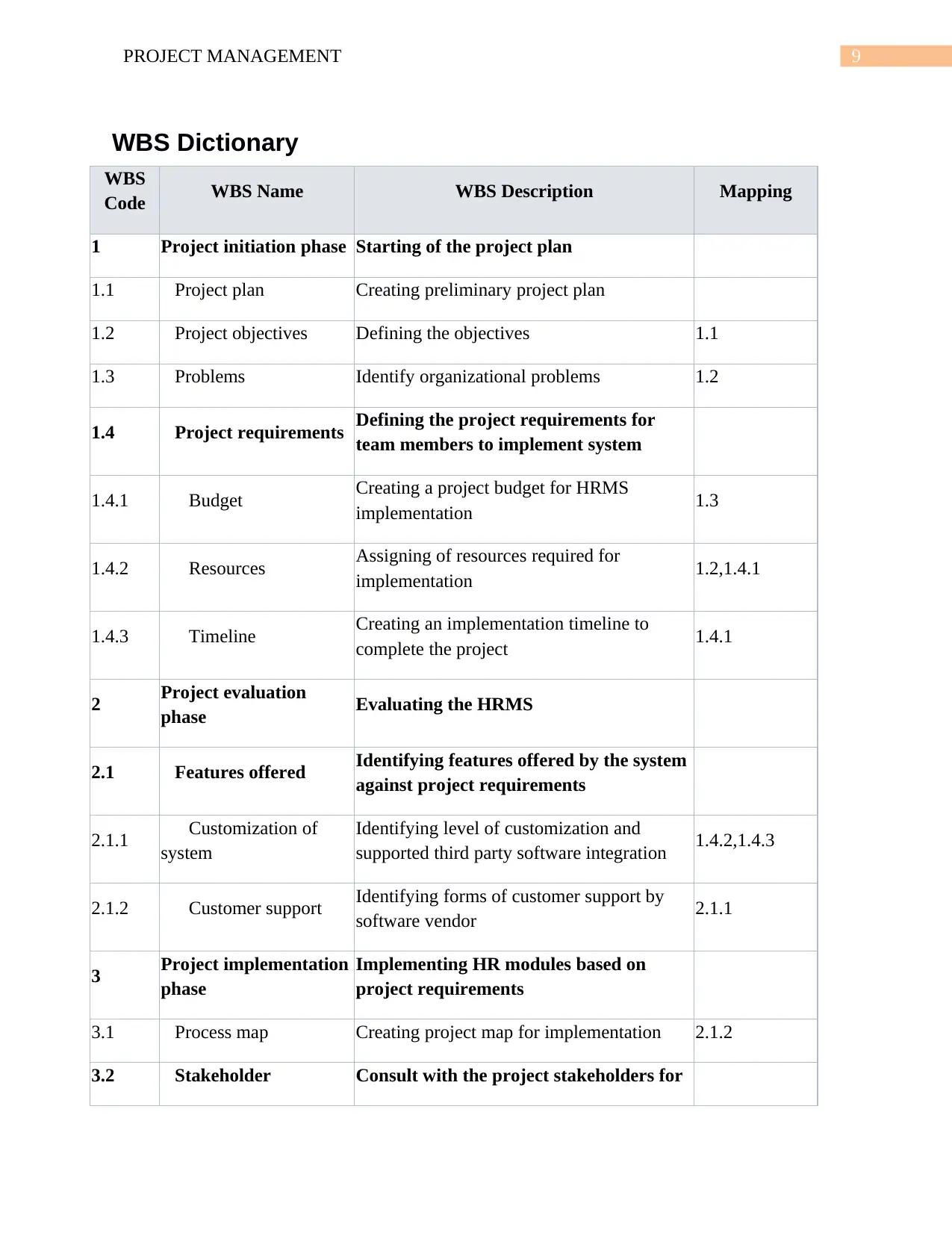
9PROJECT MANAGEMENT
WBS Dictionary
WBS
Code WBS Name WBS Description Mapping
1 Project initiation phase Starting of the project plan
1.1 Project plan Creating preliminary project plan
1.2 Project objectives Defining the objectives 1.1
1.3 Problems Identify organizational problems 1.2
1.4 Project requirements Defining the project requirements for
team members to implement system
1.4.1 Budget Creating a project budget for HRMS
implementation 1.3
1.4.2 Resources Assigning of resources required for
implementation 1.2,1.4.1
1.4.3 Timeline Creating an implementation timeline to
complete the project 1.4.1
2 Project evaluation
phase Evaluating the HRMS
2.1 Features offered Identifying features offered by the system
against project requirements
2.1.1 Customization of
system
Identifying level of customization and
supported third party software integration 1.4.2,1.4.3
2.1.2 Customer support Identifying forms of customer support by
software vendor 2.1.1
3 Project implementation
phase
Implementing HR modules based on
project requirements
3.1 Process map Creating project map for implementation 2.1.2
3.2 Stakeholder Consult with the project stakeholders for
WBS Dictionary
WBS
Code WBS Name WBS Description Mapping
1 Project initiation phase Starting of the project plan
1.1 Project plan Creating preliminary project plan
1.2 Project objectives Defining the objectives 1.1
1.3 Problems Identify organizational problems 1.2
1.4 Project requirements Defining the project requirements for
team members to implement system
1.4.1 Budget Creating a project budget for HRMS
implementation 1.3
1.4.2 Resources Assigning of resources required for
implementation 1.2,1.4.1
1.4.3 Timeline Creating an implementation timeline to
complete the project 1.4.1
2 Project evaluation
phase Evaluating the HRMS
2.1 Features offered Identifying features offered by the system
against project requirements
2.1.1 Customization of
system
Identifying level of customization and
supported third party software integration 1.4.2,1.4.3
2.1.2 Customer support Identifying forms of customer support by
software vendor 2.1.1
3 Project implementation
phase
Implementing HR modules based on
project requirements
3.1 Process map Creating project map for implementation 2.1.2
3.2 Stakeholder Consult with the project stakeholders for
Paraphrase This Document
Need a fresh take? Get an instant paraphrase of this document with our AI Paraphraser
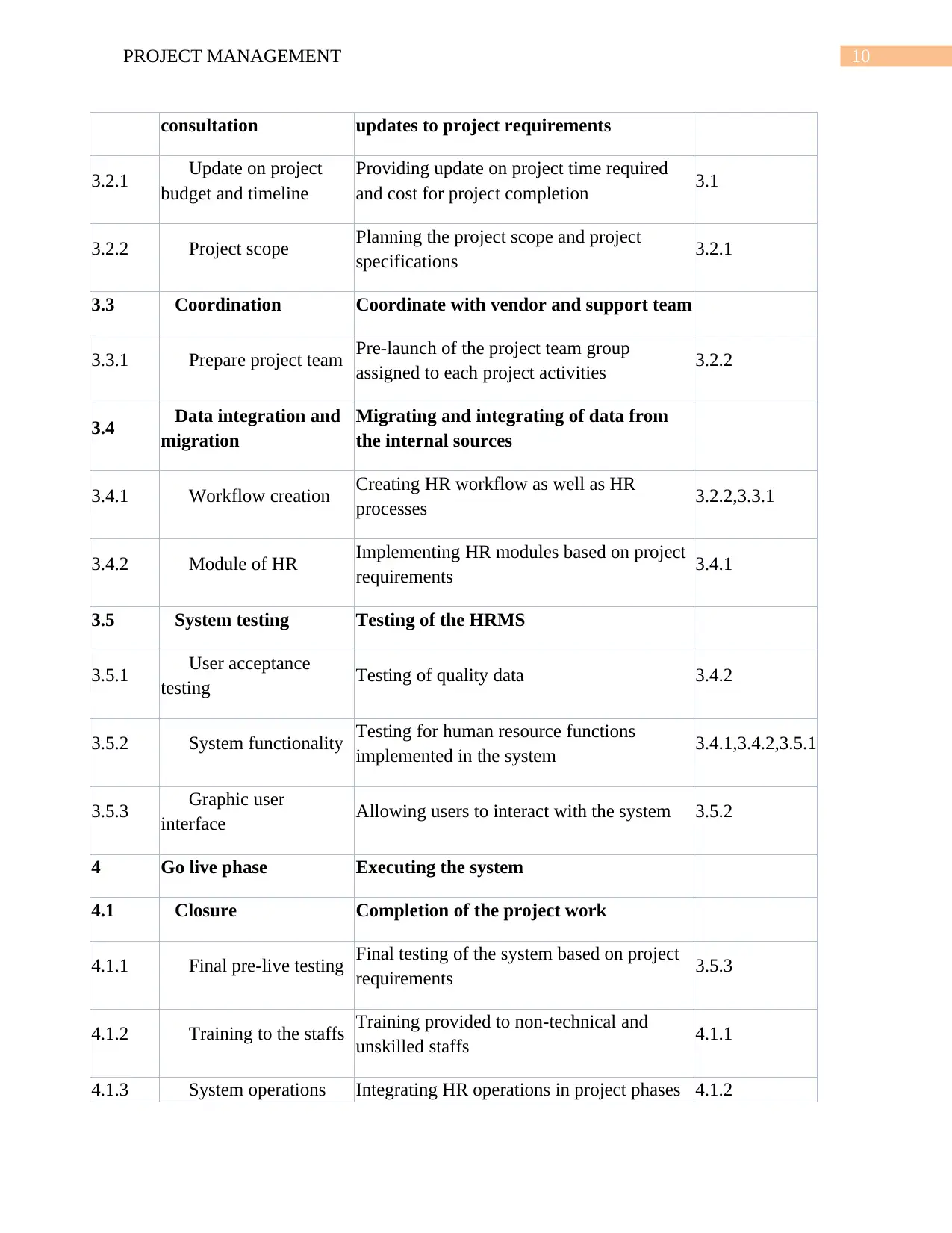
10PROJECT MANAGEMENT
consultation updates to project requirements
3.2.1 Update on project
budget and timeline
Providing update on project time required
and cost for project completion 3.1
3.2.2 Project scope Planning the project scope and project
specifications 3.2.1
3.3 Coordination Coordinate with vendor and support team
3.3.1 Prepare project team Pre-launch of the project team group
assigned to each project activities 3.2.2
3.4 Data integration and
migration
Migrating and integrating of data from
the internal sources
3.4.1 Workflow creation Creating HR workflow as well as HR
processes 3.2.2,3.3.1
3.4.2 Module of HR Implementing HR modules based on project
requirements 3.4.1
3.5 System testing Testing of the HRMS
3.5.1 User acceptance
testing Testing of quality data 3.4.2
3.5.2 System functionality Testing for human resource functions
implemented in the system 3.4.1,3.4.2,3.5.1
3.5.3 Graphic user
interface Allowing users to interact with the system 3.5.2
4 Go live phase Executing the system
4.1 Closure Completion of the project work
4.1.1 Final pre-live testing Final testing of the system based on project
requirements 3.5.3
4.1.2 Training to the staffs Training provided to non-technical and
unskilled staffs 4.1.1
4.1.3 System operations Integrating HR operations in project phases 4.1.2
consultation updates to project requirements
3.2.1 Update on project
budget and timeline
Providing update on project time required
and cost for project completion 3.1
3.2.2 Project scope Planning the project scope and project
specifications 3.2.1
3.3 Coordination Coordinate with vendor and support team
3.3.1 Prepare project team Pre-launch of the project team group
assigned to each project activities 3.2.2
3.4 Data integration and
migration
Migrating and integrating of data from
the internal sources
3.4.1 Workflow creation Creating HR workflow as well as HR
processes 3.2.2,3.3.1
3.4.2 Module of HR Implementing HR modules based on project
requirements 3.4.1
3.5 System testing Testing of the HRMS
3.5.1 User acceptance
testing Testing of quality data 3.4.2
3.5.2 System functionality Testing for human resource functions
implemented in the system 3.4.1,3.4.2,3.5.1
3.5.3 Graphic user
interface Allowing users to interact with the system 3.5.2
4 Go live phase Executing the system
4.1 Closure Completion of the project work
4.1.1 Final pre-live testing Final testing of the system based on project
requirements 3.5.3
4.1.2 Training to the staffs Training provided to non-technical and
unskilled staffs 4.1.1
4.1.3 System operations Integrating HR operations in project phases 4.1.2
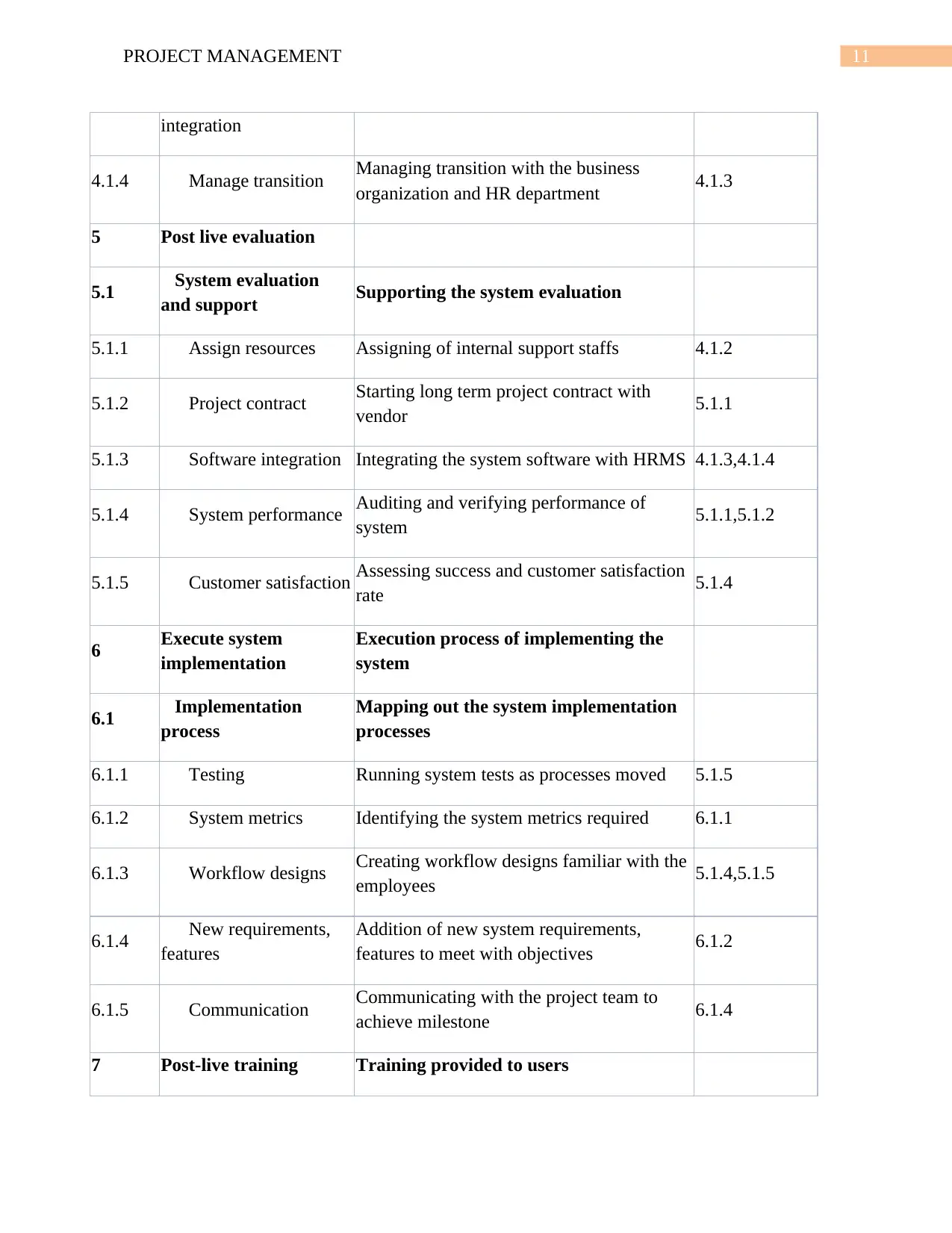
11PROJECT MANAGEMENT
integration
4.1.4 Manage transition Managing transition with the business
organization and HR department 4.1.3
5 Post live evaluation
5.1 System evaluation
and support Supporting the system evaluation
5.1.1 Assign resources Assigning of internal support staffs 4.1.2
5.1.2 Project contract Starting long term project contract with
vendor 5.1.1
5.1.3 Software integration Integrating the system software with HRMS 4.1.3,4.1.4
5.1.4 System performance Auditing and verifying performance of
system 5.1.1,5.1.2
5.1.5 Customer satisfaction Assessing success and customer satisfaction
rate 5.1.4
6 Execute system
implementation
Execution process of implementing the
system
6.1 Implementation
process
Mapping out the system implementation
processes
6.1.1 Testing Running system tests as processes moved 5.1.5
6.1.2 System metrics Identifying the system metrics required 6.1.1
6.1.3 Workflow designs Creating workflow designs familiar with the
employees 5.1.4,5.1.5
6.1.4 New requirements,
features
Addition of new system requirements,
features to meet with objectives 6.1.2
6.1.5 Communication Communicating with the project team to
achieve milestone 6.1.4
7 Post-live training Training provided to users
integration
4.1.4 Manage transition Managing transition with the business
organization and HR department 4.1.3
5 Post live evaluation
5.1 System evaluation
and support Supporting the system evaluation
5.1.1 Assign resources Assigning of internal support staffs 4.1.2
5.1.2 Project contract Starting long term project contract with
vendor 5.1.1
5.1.3 Software integration Integrating the system software with HRMS 4.1.3,4.1.4
5.1.4 System performance Auditing and verifying performance of
system 5.1.1,5.1.2
5.1.5 Customer satisfaction Assessing success and customer satisfaction
rate 5.1.4
6 Execute system
implementation
Execution process of implementing the
system
6.1 Implementation
process
Mapping out the system implementation
processes
6.1.1 Testing Running system tests as processes moved 5.1.5
6.1.2 System metrics Identifying the system metrics required 6.1.1
6.1.3 Workflow designs Creating workflow designs familiar with the
employees 5.1.4,5.1.5
6.1.4 New requirements,
features
Addition of new system requirements,
features to meet with objectives 6.1.2
6.1.5 Communication Communicating with the project team to
achieve milestone 6.1.4
7 Post-live training Training provided to users
⊘ This is a preview!⊘
Do you want full access?
Subscribe today to unlock all pages.

Trusted by 1+ million students worldwide
1 out of 15
Related Documents
Your All-in-One AI-Powered Toolkit for Academic Success.
+13062052269
info@desklib.com
Available 24*7 on WhatsApp / Email
![[object Object]](/_next/static/media/star-bottom.7253800d.svg)
Unlock your academic potential
Copyright © 2020–2025 A2Z Services. All Rights Reserved. Developed and managed by ZUCOL.





